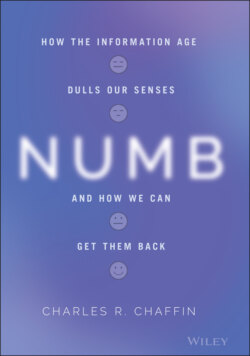Читать книгу Numb - Charles R. Chaffin - Страница 11
By‐Products of This Information Age
ОглавлениеAt the risk of stating the obvious, the goals for the technology around us are not consistent with our own personal goals. Media outlets – through nonstop news coverage and clickbait headlines – are designed to lure us onto their channels and sites. Social media has a vested interest in keeping you on their platforms for as long as possible through the use of algorithms and clever little “rewards” that we will discuss later in the book. We engage in our newsfeeds or the endless recommended videos on YouTube at the expense of many of our short‐ and long‐term goals. Echo chambers and outrage machines keep us emotionally vested in content that we post and engage. When it comes to social media platforms, as Mark Weinstein describes it, “We are not the users, we are the product.” The realization that something you engage routinely is not aligned with your goals is obvious but also important. Think about other technology around us. Our cars, washing machines, and microwaves are all designed to meet our goals, whether it's transportation or popping popcorn. Our smartphones, and all of the apps that go along with it, are not the same. They have important functions in our daily lives, but it is not as simple as giving us what we both want and need to live our best lives. There is at best a Venn diagram between our goals and theirs with a definite yet small crossover. It is not a complete alignment.
Averaging close to four hours of screen time a day, we have become reliant upon social media as a primary outlet to engage others, some of whom we know and some we don't. This connection through technology is valuable when it accompanies in‐person relationships, but is isolating if it is our primary vehicle for engagement with others. When we connect in person, whether with a colleague or a friend, we witness the facial expressions and the vocal inflections that come from the dialogue. The processed element of connecting via instant message lacks authenticity, leaving those who stay online for hours per day isolated. In many respects, technology places us in a bubble that we carry with us, isolating us from the people around us and limiting authentic interactions with new people. In her book Alone Together, MIT professor Sherry Turkle states, “a train station (like an airport, a café, or a park) is no longer a communal space but a place of social collections. People come together but do not speak to each other. Each is tethered to a mobile device and to the people and places to which that device serves as a portal.” Ironically, our constant connection in some respect makes us more disconnected, even when surrounded by other humans, potentially other lonely humans.
The sensationalism that comes from news exposes us to the suffering of others on a daily, if not hourly, basis. This makes the act of viewing suffering mundane, creating potential compassion fatigue. The echo chambers that are created within social media impact not only how we view important issues as voters and citizens, but also how we engage and treat one another. We also face an onslaught of daily decisions via technology. We have become overwhelmed with choice, whether it is in the dairy aisle or on Tinder. How do we navigate all these options without becoming incapacitated? Given the ability of our smartphones to lure us into a habit of scrolling, how do we develop a well‐balanced diet of social media without it limiting other aspects of our lives? What about tribalism, sensationalism, FOMO, outrage, confirmation bias, and a host of other factors that confront us every day in this information age? We seem aware, yet uninformed and polarized. Outraged, yet apathetic. When I think of all of the push and pull of our attention that comes from this information and perhaps most importantly, the psychological impacts of all of it, the word that always comes front of mind is numb.
The sports broadcaster Beano Cook once said, “Life in the 1960s was far better, with three notable exceptions: Medicine, civil rights, and air conditioning.” Although certainly clever with some truth to it, life today has many benefits beyond the three he mentioned. This age of information brings with it numerous possibilities. We have the ability to communicate with people from every corner of the globe who bring different worldviews and perspectives to important topics as well as our own life. Medical breakthroughs can be achieved through online collaboration and dissemination to a broad group of scientists. Look no further than the COVID‐19 pandemic to see the benefit of large‐scale international medical collaborations that could only be advanced through this information age. We have the ability to be better‐informed consumers, voters, worshippers, and professionals through our access to information. It is a matter of finding the right balance of accessing information that makes our lives better, engaging enough of the news to be well‐informed, and connecting with social media in both a positive and genuine way. The solution to meeting all of our short‐ and long‐term goals is not eliminating all of our technology. Rather, it is finding the right balance with information and technology in our personal and professional lives. Each of us has to decide if this information age really and truly makes our lives better. Perhaps there are tweaks you can make in your relationship with social media, cable news, or dating apps. You might have initially engaged social media or dating apps thinking they would be useful to become more connected. Has that goal been achieved? Have you been realizing that lately you have become too connected? I hope the insight from this book, and the reflective process that goes along with it, will help you answer those questions and find the right balance. I hope that it is a worthwhile journey.
